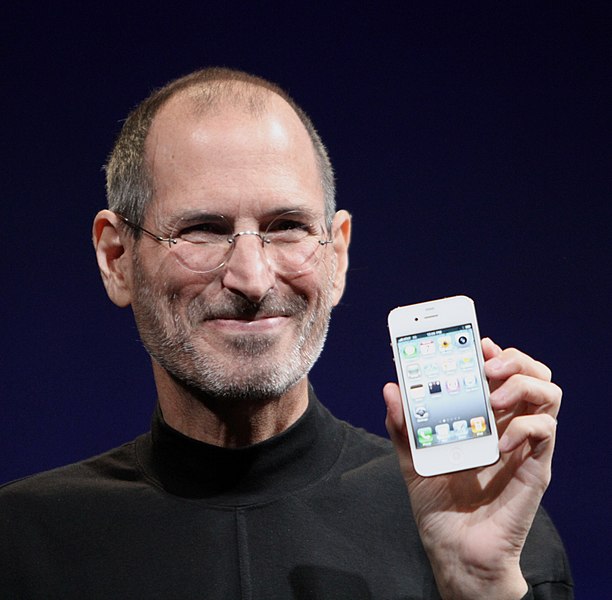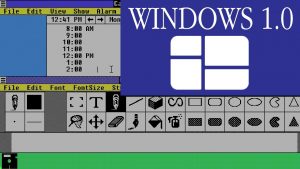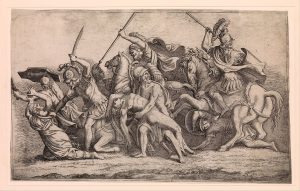“Today, we’re introducing three revolutionary products of this class. The first one is a wide screen iPod with touch control, the second is a revolutionary mobile phone and the third is a break-through internet communications device. So, three things a wide screen iPod with touch controls, a revolutionary mobile phone, and a breakthrough internet communications device. An iPod, a phone, and an internet communicator. An iPod a phone. Are you getting it? These are not 3 separate devices; this is one device and we are calling it iPhone.”1
Steve Jobs used this opening at the 2007 unveiling of the brand-new iPhone. The iPhone revolutionized the mobile phone industry. This is just one of the many achievements Steve Jobs accomplished during his lifetime working with Apple, but how did Steve Jobs go from a college dropout to the co-founder of Apple?

Jobs didn’t have a good relationship with most of the employees at Atari. They complained about his attitude and his hygiene. After being confronted by his boss, Jobs demanded that he be allowed to work on his own projects by himself. After some convincing, his boss, Al Alcorn gave him his own project to create a game with a tight deadline for a couple thousand dollars, as well as having him work at night when no one else was in the office. Working on the project for a day, Jobs realized he didn’t have the skill to work on the technical side, but his friend Steve Wozniak did. Jobs requested help from Wozniak to complete the game. Upon completion, Jobs showed the game to his boss. Visiting Wozniak afterwards, Jobs gave him $350 for his help with the game, telling Wozniak that he was only paid $700 instead of the actual couple thousand dollars he made.2
Hanging out with Wozniak, Jobs learns about Wozniak’s vision of a personal computer that would have a screen and a typewriter-like input device. This idea differed greatly from the standard personal computer at the time, which was a board with switches and lights that you would use as input and output devices. Upon hearing this idea, Jobs envisioned this device as a revolutionary piece of technology. Jobs, wanting to bring this device to life, helped Wozniak put together the device by providing parts. Jobs was able to convince engineers at Intel to donate DRAM chips or memory chips. With this type of help from Jobs, Wozniak was able to bring his vision to life. This device would become the basis of the Apple I computer.3

Once the computer was completed, Wozniak presented it to his friends at the Homebrew Club, a place where technicians could talk to each other about technology they created or knew about. At this presentation, Wozniak gave out plans on how to create one, but few succeed in recreating the computer. Upon learning about the failure of others, Jobs proposed to Wozniak that they start a business selling the circuit boards to people. People would buy the main circuit boards from them and put it together with other parts to create a computer. Although Wozniak doubted that they could find enough people to buy the circuit boards, he reluctantly agreed to work with Jobs. Once they decided that they would sell circuit boards, they needed a name for their new company. Jobs wanted a name that didn’t sound technical, but that would attract regular people and not just technicians. Steve Jobs had recently visited the All One Farm, which was a commune in Oregon owned by Jobs’ friend Robert Friedland. Jobs had taken care of the apple orchard located here, and that suggested to him the name Apple Computers.4
Needing money to fund the creation of their computers, Jobs had to sell his van and Wozniak sold his calculator making a total of $1250. A man named Paul Terrel, who attended Wozniak’s presentation at the Homebrew Club, became interested in the computer Wozniak made. Approaching Jobs after the presentation, he told him to stay in touch, and Paul Terrel then received a visit from Jobs at his store. During this visit, Jobs convinced Terrel to order fifty of their computers for $25,000. After deciding that making 50 boards would take too much time by themselves, they decided to mass-produce the boards with a manufacturing company. However, due to the engineers at the manufacturing company being unable to follow Wozniak’s design, Jobs hired an engineer from Atari, Ron Wayne, to draw new schematics that were easier to follow, based on Wozniak’s design. Still in the early stages of their company, Jobs and Wozniak needed parts to put the computers together. In order to get parts, Jobs persuaded a local electronics supply companies to give him parts on credit. After working hard, the circuit boards were completed. Upon delivering the boards to Terrel’s store, Jobs was paid $500 per unit, making a total of $25,000.5 After immediately getting paid, Jobs went to the local electronics supply store and paid off the parts he had received from them on credit.6

Unable to afford an actual office to work out of, Jobs and Wozniak used Jobs’ garage as their main headquarters, which was a fact they tried to keep secret when making deals. In order to look professional, Jobs opened a post office box and created an answering service. In order to increase the production speed of their Apple I computer, Jobs hired their friend Bill Fernandez to help them out. By hiring Jobs’ sister, Patty, and his other friend Dan Kottke, they designed an assembly style way of building their computer. Bill, Dan, and Patty all worked on attaching parts to the circuit boards Jobs brought back from the mass production company. Once they completed a board, Wozniak tested it by connecting it to a monitor and a keyboard. After testing a board, Wozniak corrected any mistakes made. By insistence of Jobs, they used only the best parts to create their computer, even if they were more expensive and not commonly used. Along with picking up boards from the production company, Jobs also went around visiting electronic stores trying to sell the Apple I. Since Jobs was so persuasive and stubborn, most stores would stock at least one of their products, which were sold for $666.66.7
Along with working to produce more Apple I computers, Wozniak regularly thought about how to improve the Apple I. Wozniak imagined that the next computer they made would support color, sound, and high-resolution graphics. Along with these details, he wanted to add a way to increase the memory of the computer. As well as adding these features, Jobs wanted to add newly created technologies to the computer, envisioning a world where everyone had a computer. To achieve this vision, Jobs was convinced that they needed a computer that came fully assembled and was easy to use. He believed that if Apple could make this, then they would change the whole world. These ideas led to the concept of the Apple II. Jobs and Wozniak continued to sell their computer by displaying the Apple I at the Personal Computer Festival in Atlantic City, New Jersey. As well as displaying the Apple I, they presented a mock build of the Apple II computer. Although the Apple II mock build wasn’t very interesting, Jobs took from the experience the idea that if they wanted to make a computer everyone could use, they would have to completely change their design. To do so, he decided they would have to sell a computer that came with a monitor, case, and keyboard. Not only focusing on the physical design, Jobs said the new computer would have to be quiet, lightweight, and attractive to the common people. To make this idea a reality, Jobs hired the industrial designer Jerry Manock to redesign the Apple II to fit his ideas. He also convinced Wozniak that they needed a lightweight power supply that wouldn’t need cooling to eliminate noise. Needing money to fund the development of the Apple II, Jobs went to banks, Atari, and Hewlett Packard to find investors. Ultimately he was denied funding due to his youth, long hair, and hippie attire. After continuously trying to find an investor, an individualist named Mike Markkula, who could look past Jobs’ appearance, came into play. Upon hearing about Jobs’ ideas and vision for the computer and world, Mike Markkula was convinced to fund them, providing $92,000 for a third of the company.8
Jobs wanted to display the Apple II at the 1977 West Coast Computer Faire. In order to meet this deadline, Jobs hired more employees to assist. The Apple II upon completion was the first easy-to-use computer to be made. The computer supported color, sound, high-resolution graphics, and attachable game paddles. Along with being the first easy-to-use computer, it was also the first computer to come with a built-in programming language. This became a standard for computers for years to come. The display at the fair was a huge success that came from Jobs’ innovation of display and marketing. Quickly, Apple Computers had received 300 orders for the new Apple II.9

Apple Computers quickly turned a profit from there, making a profit of two million dollars by 1978 to making $335 million by 1980, Apple Computers was a success. Even more money came their way when the company went public, allowing the public to buy shares. Apple shares started at $22. Jobs’ net worth was more than $217 million, making Jobs the youngest person in history to be on the Fortune 400 list of tycoons.10
A world-changing visionary, and global leading entrepreneur, Steve Jobs completely revolutionized the idea of the personal computer and electronics. Starting with the Apple I computer and continuing with the Apple II, he tore down the ideas of what a personal computer was and showcased the idea of a personal computer that the everyday man could use. Not stopping with the personal computer, he continued to change the mobile phone and the portable music player industries. Continuing to improve his work until his untimely death, he completely changed the use of technology in everyday life. With all his work and achievements, Steve Jobs has become a household name across the country maybe even the world.
- “Steve Jobs unveils the iPhone,” Video file, 5:01, YouTube, posted by CNET, January 9, 2017 https://www.youtube.com/watch?v=LOb3FJhDbYs. ↵
- Barbara Sheen, Steve Jobs (Detroit, Mich. : Lucent Books, 2010), 33-36. ↵
- Barbara Sheen, Steve Jobs (Detroit, Mich. : Lucent Books, 2010), 38-39. ↵
- Barbara Sheen, Steve Jobs (Detroit, Mich. : Lucent Books, 2010), 40-42. ↵
- Michael B. Becraft, Steve Jobs: A Biography (Santa Barbara, California: Greenwood, 2017), 35. ↵
- Barbara Sheen, Steve Jobs (Detroit, Mich. : Lucent Books, 2010), 43-44. ↵
- Barbara Sheen, Steve Jobs (Detroit, Mich. : Lucent Books, 2010), 44-45. ↵
- Barbara Sheen, Steve Jobs (Detroit, Mich. : Lucent Books, 2010), 46-49. ↵
- Barbara Sheen, Steve Jobs (Detroit, Mich. : Lucent Books, 2010), 49-50. ↵
- Barbara Sheen, Steve Jobs (Detroit, Mich. : Lucent Books, 2010), 50. ↵



34 comments
Luke Jordan
I thoroughly enjoyed the article. My biggest take away from this article was seeing how Steve Jobs thought outside of the box when it came to technology and how he envisioned the idea of a personal computer that everyone would own. As we have seen over the past few decades this has come true. Almost every college student in the country has a personal computer. Steve Jobs really changed the way people view technology with his countless innovations and I find it very inspiring how he was a bit of an outsider at Atari but never stopped being himself and believing in himself which I believe fueled his success.
Maya Simon
This is my first time hearing about Steve Wozniak I’ve always known about Steve Jobs because he is the one doing all the talking and he’s basically the face of the franchise. This article shows you how you can do so much but yet still be left without the actual credit that you deserve. This was a great article it really taught me a lot, great job.
Nathan Castillo
After reading this article, I never knew there was someone else behind when helping out creating the first Apple product, that being Steve Wozniak. Steve is credited a lot for the creation of Apple and its product, but it was very nice to know that Steve was not alone. Being in a business class right now, I keep thinking about how businesses form and how they can succeed or struggle. This was a very interesting article!
Emmett Pena
Steve Jobs is often credited as being the face of Apple, but without Steve Wozniak the dream of having a personal, everyday computer would not have happened. The history of Apple has always been intriguing because of the work grind Jobs and Wozniak had to do to make it to the top of the computer industry. The author did a fantastic job of describing how the idea of these two men changed the way we communicate today.
Cayden Garcia
It is crazy to think that one man’s invention could fuel the future of society. Everywhere you look today, Steve Job’s influence is shown. Whether it is the phones that we use, the laptops that we work on, or the T.V’s we use to watch our favorite show, Steve Job’s ideas or there. Personally, I have used an iPhone for the last 7 years, and the things that this device can do is truly astonishing. You did a great job describing Steve as a person, as well as his inventions
Great Job!!
Janaya Felder
It’s fascinating to see how far Apple has come since the creation of Apple 1. I didn’t even know Apple 1 and 2 were the two inventions that began the world changing way technology is used and created. Comparing the picture of Apple 1 to my iPhone is an amazing way to truly see how far the design of Apple products have come. Reading about the other individuals that helped Jobs begin his journey in creating Apple was refreshing since they are often looked over. Wozniak played an extremely important role in the creation of Apple and I don’t think Jobs could have gotten as far as he did without his help and the help of their friends.
Micheal Baladez
After reading this article, I found it rather incredible how much Apple’s, and by extension, Steve’s technology has changed the world around us. This man achieved so much in his lifetime despite it being cut short by Pancreatic Cancer. By founding one of the biggest tech companies within the modern day, this man unknowingly started a movement, Apple is the only Trillion Dollar company in the world. However, it was interesting to learn that Steve did, in fact, have people who assisted him in being successful, primarily because they are all basically never mentioned whenever Steve’s success is brought into the conversation. Moreover, learning about those whom he worked alongside with as well as the struggles that they all went through did serve to be a very intriguing read. Overall, this is a very well written article with numerous facts and statements that presents a clear and concise message to the audience.
Daniel Gimena
It was nice to read a little bit more in depth about how Apple became the company we know today.
It is always inspiring to read about people like Steve Jobs (and Steve Wozniak).
The first thing that comes to mind when we think about those people is that they are in the group of the richest people on earth. But it is good to read articles like this one, which shows us how hard those people had to work daily to become the people we know today.
In Steve Jobs’ case, what I admire the most is how that man, without being a technology genius (that was Steve Wozniak), accomplished with hard work and dedication to find funding for his projects, to get always better products and to keep going after failing over and over again.
Stories like this, show us that every beginning is difficult because the first human reaction to something unknown is rejection. But hard work, dedication and faith in what you are doing will bring you to accomplish big things that can change the world.
Aaron Sandoval
It is very difficult to look back and envision a time before the iPhone, especially in our generation. For many of us, the iPhone was our first phone, and Apple has always staked a claim in our technological lives. It is interesting to realize that this soon to be technological empire that could be found in the homes of millions started in a garage is awe-inspiring and proves that anything is possible.
Andrea Degollado
I fond this article very intriguing because apple is a company that hasn’t been around for a very long time but is one of the most popular companies in the world. I think its incredible how Steve Jobs inventions were able to revolutionize our generation. I think its very interesting how this article focused on the computer rather then the iPhone. Very well written article!